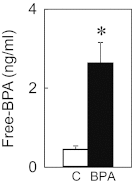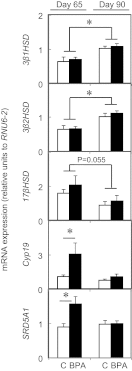Developmental programming: gestational bisphenol-A treatment alters trajectory of fetal ovarian gene expression
- PMID: 23525218
- PMCID: PMC3628019
- DOI: 10.1210/en.2012-2129
Developmental programming: gestational bisphenol-A treatment alters trajectory of fetal ovarian gene expression
Abstract
Bisphenol-A (BPA), a ubiquitous environmental endocrine disrupting chemical, is a component of polycarbonate plastic and epoxy resins. Because of its estrogenic properties, there is increasing concern relative to risks from exposures during critical periods of early organ differentiation. Prenatal BPA treatment in sheep results in low birth weight, hypergonadotropism, and ovarian cycle disruptions. This study tested the hypothesis that gestational exposure to bisphenol A, at an environmentally relevant dose, induces early perturbations in the ovarian transcriptome (mRNA and microRNA). Pregnant Suffolk ewes were treated with bisphenol A (0.5 mg/kg, sc, daily, produced ∼2.6 ng/mL of unconjugated BPA in umbilical arterial samples of BPA treated fetuses approaching median levels of BPA measured in maternal circulation) from days 30 to 90 of gestation. Expression of steroidogenic enzymes, steroid/gonadotropin receptors, key ovarian regulators, and microRNA biogenesis components were measured by RT-PCR using RNA derived from fetal ovaries collected on gestational days 65 and 90. An age-dependent effect was evident in most steroidogenic enzymes, steroid receptors, and key ovarian regulators. Prenatal BPA increased Cyp19 and 5α-reductase expression in day 65, but not day 90, ovaries. Fetal ovarian microRNA expression was altered by prenatal BPA with 45 down-regulated (>1.5-fold) at day 65 and 11 down-regulated at day 90 of gestation. These included microRNAs targeting Sry-related high-mobility-group box (SOX) family genes, kit ligand, and insulin-related genes. The results of this study demonstrate that exposure to BPA at an environmentally relevant dose alters fetal ovarian steroidogenic gene and microRNA expression of relevance to gonadal differentiation, folliculogenesis, and insulin homeostasis.
Figures




Comment in
-
Bisphenol a: a model endocrine disrupting chemical with a new potential mechanism of action.Endocrinology. 2013 Jun;154(6):1962-4. doi: 10.1210/en.2013-1370. Endocrinology. 2013. PMID: 23687111 Free PMC article. No abstract available.
Similar articles
-
Developmental programming: Sex-specific programming of growth upon prenatal bisphenol A exposure.J Appl Toxicol. 2019 Nov;39(11):1516-1531. doi: 10.1002/jat.3836. Epub 2019 Jul 23. J Appl Toxicol. 2019. PMID: 31338854 Free PMC article.
-
Developmental programming: gestational testosterone treatment alters fetal ovarian gene expression.Endocrinology. 2011 Dec;152(12):4974-83. doi: 10.1210/en.2011-1182. Epub 2011 Oct 18. Endocrinology. 2011. PMID: 22009729 Free PMC article.
-
Developmental programming: differential effects of prenatal exposure to bisphenol-A or methoxychlor on reproductive function.Endocrinology. 2006 Dec;147(12):5956-66. doi: 10.1210/en.2006-0805. Epub 2006 Aug 31. Endocrinology. 2006. PMID: 16946013
-
Reproduction Symposium: developmental programming of reproductive and metabolic health.J Anim Sci. 2014 Aug;92(8):3199-210. doi: 10.2527/jas.2014-7637. J Anim Sci. 2014. PMID: 25074449 Free PMC article. Review.
-
Developmental reprogramming of reproductive and metabolic dysfunction in sheep: native steroids vs. environmental steroid receptor modulators.Int J Androl. 2010 Apr;33(2):394-404. doi: 10.1111/j.1365-2605.2009.01024.x. Epub 2010 Jan 12. Int J Androl. 2010. PMID: 20070410 Free PMC article. Review.
Cited by
-
MicroRNAs in ovarian function and disorders.J Ovarian Res. 2015 Aug 1;8:51. doi: 10.1186/s13048-015-0162-2. J Ovarian Res. 2015. PMID: 26232057 Free PMC article. Review.
-
Toxicological Impact of Bisphenol A on Females' Reproductive System: Review Based on Experimental and Epidemiological Studies.Reprod Sci. 2024 Jul;31(7):1781-1799. doi: 10.1007/s43032-024-01521-y. Epub 2024 Mar 26. Reprod Sci. 2024. PMID: 38532232 Review.
-
Gestational Exposure to Bisphenol A and Bisphenol S Leads to Fetal Skeletal Muscle Hypertrophy Independent of Sex.Toxicol Sci. 2019 Dec 1;172(2):292-302. doi: 10.1093/toxsci/kfz198. Toxicol Sci. 2019. PMID: 31501865 Free PMC article.
-
Potential Mechanisms of Bisphenol A (BPA) Contributing to Human Disease.Int J Mol Sci. 2020 Aug 11;21(16):5761. doi: 10.3390/ijms21165761. Int J Mol Sci. 2020. PMID: 32796699 Free PMC article. Review.
-
Evidence for bisphenol A-induced female infertility: a review (2007-2016).Fertil Steril. 2016 Sep 15;106(4):827-56. doi: 10.1016/j.fertnstert.2016.06.027. Epub 2016 Jul 12. Fertil Steril. 2016. PMID: 27417731 Free PMC article. Review.
References
-
- Hartgens F, Kuipers H. Effects of androgenic-anabolic steroids in athletes. Sports Med. 2004;34:513–554 - PubMed
-
- Waller DK, Gallaway MS, Taylor LG, et al. Use of oral contraceptives in pregnancy and major structural birth defects in offspring. Epidemiology. 2010;21:232–239 - PubMed
-
- Heindel JJ, vom Saal FS. Role of nutrition and environmental endocrine disrupting chemicals during the perinatal period on the aetiology of obesity. Mol Cell Endocrinol. 2009;304:90–96 - PubMed
Publication types
MeSH terms
Substances
Grants and funding
LinkOut - more resources
Full Text Sources
Other Literature Sources
Miscellaneous

